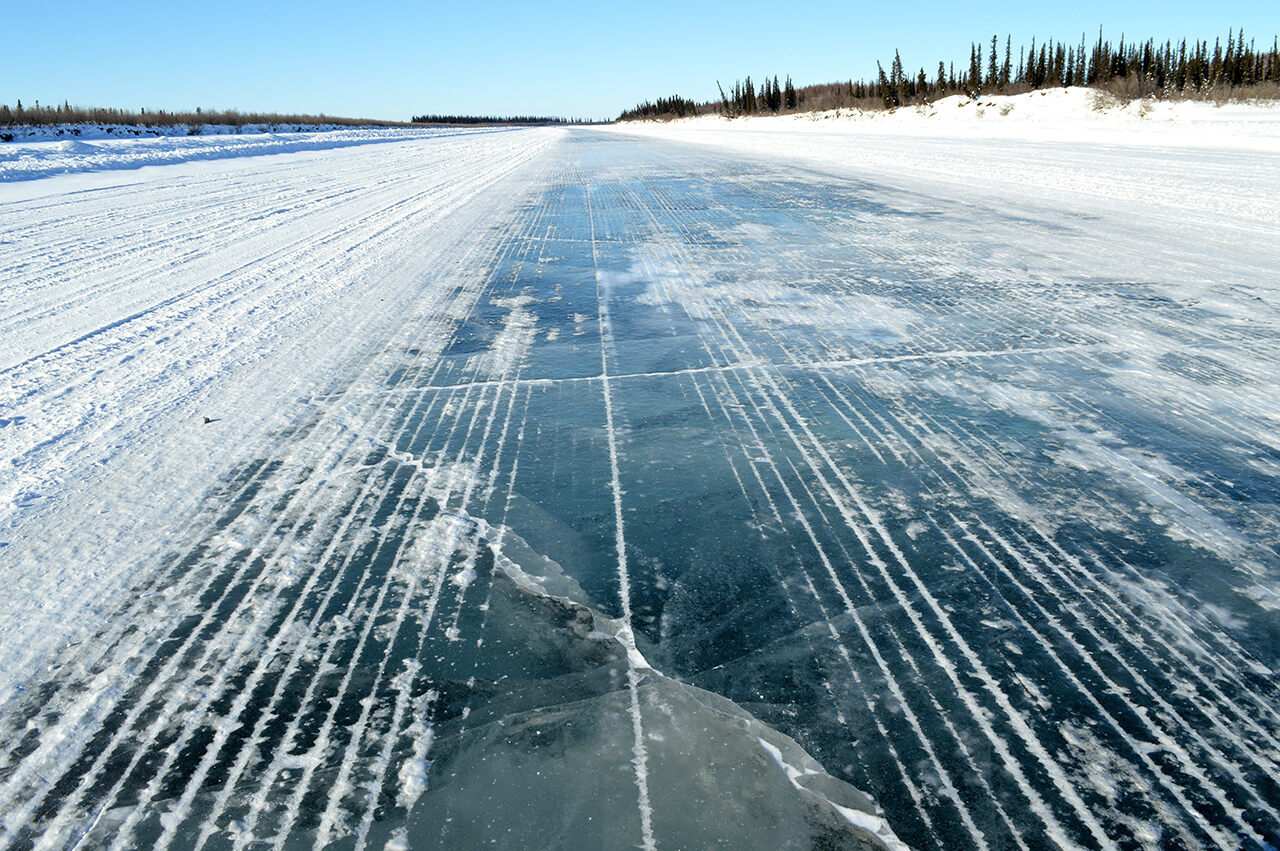Welcome to DU!
The truly grassroots left-of-center political community where regular people, not algorithms, drive the discussions and set the standards.
Join the community:
Create a free account
Support DU (and get rid of ads!):
Become a Star Member
Latest Breaking News
General Discussion
The DU Lounge
All Forums
Issue Forums
Culture Forums
Alliance Forums
Region Forums
Support Forums
Help & Search
Environment & Energy
Related: About this forumUncertain Future For Canada's ice Roads, But Conventional Roads May Not Be The Answer

The 73-mile-long Inuvik-Aklavik Ice Road forms each year when the Mackenzie River freezes over. Mady MacDonald / Shutterstock
It’s March in Canada’s Northwest Territories, almost 200 miles above the Arctic Circle, and the Mackenzie River Delta is frozen solid. Seen from above, its marbled surface is laced with cracks, criss-crossing one another and extending deep below the top layer of ice. It’s beautiful to look at, especially in the clear arctic light of a winter midday. But it’s difficult to reconcile something so fragile-looking with the 54 vehicles that drive over it on a typical March day. As Noel Cockney of the Inuit-owned Tundra North Tours tells a small group of travelers bundled into his van, this isn’t just a frozen river. This is the Inuvik-Aklavik Ice Road.
The 73-mile-long seasonal highway that connects the town of Inuvik, the region’s administrative center, to the remote community of Aklavik later takes the group past an immobilized barge, two stories high, encased in ice when the river froze around it. Come springtime the barge will be free again—and Aklavik will once more be inaccessible by land.

To reach Inuvik, the region’s administrative center, hang a left. Bear right for the remote hamlets of Tuktoyaktuk and Aklavik. Tawna Brown / Alamy
EDIT
For year-round residents like the Gordons, the ice road is crucial to accessing Aklavik in winter. But like much else these days, it’s being affected and afflicted by climate change. “I’m 30 years old, and even I have seen a difference,” says Cockney, who hails from the Inuvialuit hamlet of Tuktoyaktuk, about a hundred miles north. Until recently, his hometown was accessible only by ice road. Now an all-weather road connects Inuvik to Tuktoyaktuk, which sits on the edge of the Arctic Ocean. But a permanent road can’t entirely shield the hamlet from the impacts of climate change: Accelerating coastal erosion is threatening homes and putting the entire community at risk.
EDIT
The rapid warming of Canada’s North is due to a number of factors, including loss of snow and sea ice, which increases absorption of solar radiation and causes more surface warming than in other regions. Thawing permafrost and coastal erosion are big problems too. “The winters have shortened by around one month in total,” says Cockney. That means the region’s crucial ice roads are closing about two weeks earlier each spring than they used to, and opening about two weeks later. As ice roads around the North melt earlier than ever before, the communities that depend on them are facing increased isolation and higher costs for basic goods, which now have to be flown or shipped in. In Aklavik a gallon of milk costs $15 (roughly $18 in U.S. dollars), while a gallon of gas runs $8 ($10).
EDIT
https://www.atlasobscura.com/articles/canada-frozen-rivers-ice-roads
InfoView thread info, including edit history
TrashPut this thread in your Trash Can (My DU » Trash Can)
BookmarkAdd this thread to your Bookmarks (My DU » Bookmarks)
2 replies, 975 views
ShareGet links to this post and/or share on social media
AlertAlert this post for a rule violation
PowersThere are no powers you can use on this post
EditCannot edit other people's posts
ReplyReply to this post
EditCannot edit other people's posts
Rec (5)
ReplyReply to this post
2 replies
 = new reply since forum marked as read
Highlight:
NoneDon't highlight anything
5 newestHighlight 5 most recent replies
= new reply since forum marked as read
Highlight:
NoneDon't highlight anything
5 newestHighlight 5 most recent replies
Uncertain Future For Canada's ice Roads, But Conventional Roads May Not Be The Answer (Original Post)
hatrack
Aug 2019
OP
bobbieinok
(12,858 posts)1. Thanks for posting.
Boomer
(4,167 posts)2. I second that thanks
I've been following hatrack's posts for years and will often pass the article link along in other forums. So the seed of news planted here ends up traveling a long way.